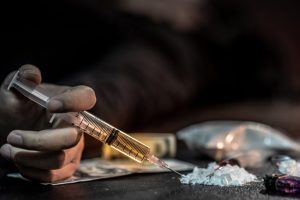On This Page:
The Deadly Effects of Fentanyl Laced Heroin
Heroin is an opioid drug that is used illegally by addicts who are seeking the euphoria it causes. It is made out of morphine, which is derived from the seed pods of the opium plant. It is an illegal drug, classified by the Drug Enforcement Administration in the United States as a Schedule I substance. As such, it is a “street drug” normally obtained through a drug dealer.
Because heroin is an illegal drug, it is difficult for researchers to determine the exact rate of use. However, a study involving people who self-reported their use found that in 2017, 494,000 United States citizens claimed to have used heroin in the last year. That’s 2 in every thousand people. In 2015, there were 81,326 emergency visits directly attributed to the use of heroin. Many of these emergencies have fatal results. In 2017 alone, there were 15,000 drug overdose deaths due to heroin abuse.
Heroin usually comes in the form of a white or black powder. However, currently one of the most popular forms of heroin is known as “black tar” and appears as a black sticky substance. Heroin can be injected, sniffed, snorted, or smoked. When heroin is mixed with a stimulant such as crack cocaine, it is known as speedballing. This practice can be particularly dangerous, as stimulants speed up the heart and depressants such as heroin slow it down.
What is fentanyl?
Fentanyl, like heroin, is an opioid. Unlike heroin, which comes from the opium plant, fentanyl is a synthetic opioid, meaning it is synthesized in a lab by scientists. Fentanyl is 50 to 100 times more powerful than morphine, the substance from which heroin is derived.
Unlike heroin, however, fentanyl is a prescription opioid, meaning it isn’t just a street drug — it is used by physicians to treat severe and chronic pain. However, prescription drugs like fentanyl also have a very high abuse rate. According to the Washington State Department of Health, addicts obtain fentanyl by misusing prescriptions, buying online, or even buying off the street.
In fact, fentanyl and other synthetic opioids have now surpassed heroin as the highest cause of drug overdoses in the United States. In 2017, 59% of opioid overdoses were attributed to fentanyl, compared to 14% in 2010. That same year, there were 28,400 deaths due to fentanyl and other synthetic opioid overdoses. Fentanyl use is on the rise. Reports from law enforcement suggest that the production and abuse of fentanyl will only continue to grow.
Mixing Fentanyl and Heroin
Drug users who have acclimated to the effects of heroin or fentanyl often combine the two substances to achieve a more intense “high.” When heroin and fentanyl are used together, however, the effects can be catastrophic. Because both drugs slow down the central nervous system, addicts who abuse both at the same time put themselves at a high risk of respiratory depression. This can be fatal.
Of particular concern to public health officials is the presence of fentanyl in many drug samples that supposedly only contain heroin. Fentanyl-laced heroin is increasingly being sold to unsuspecting drug addicts. Sometimes this occurs accidentally, but more often drug dealers will “cut” or “lace” heroin with fentanyl, which is a cheaper and more potent alternative. This presents a web of dangers to anyone taking the substance, as the increased potency of fentanyl can result in an overdose.
Recognizing a Fentanyl Laced Heroin Overdose
One sign that heroin has been laced with fentanyl is if the effects are particularly strong. When an overdose occurs, multiple effects set in very rapidly. Among these are difficulty breathing. When respiratory depression occurs, the addict may find their breathing slowed or stopped entirely. The skin can become cold. The pupils may shrink down to the size of pinpoints. Often, someone who is overdosing becomes confused. Ultimately, they may even lose consciousness and become unresponsive.
Long Term Consequences of Heroin and Fentanyl Abuse
Over the long term, the high that heroin and fentanyl provide will weaken as the opioid receptors in the brain adapt. Additionally, withdrawal symptoms become more severe as an addiction develops. This requires drug users to seek out greater and greater quantities of the drug or use it at a higher rate of frequency.
With time, abuse of the drug and fear of withdrawal can take over and ruin an addict’s life, causing problems of seemingly insurmountable proportions with health, relationships, and money.
For drug users abusing heroin and fentanyl in combination or alone, it is crucial to seek appropriate health care. This might involve going through medical detox. Recovery residence programs for addiction such as sober living homes can also be beneficial.
These programs allow an addict to recover from the immediate consequences of their drug addiction and get the supervision they need. Over the long term, recovery programs provide the addict with the tools and social support system they need to overcome addiction for the long haul.
Get Help in Design For Recovery Today!
Fentanyl-laced heroin is a dangerous and potentially deadly drug that can lead to addiction and even overdose. If you or someone you know is struggling with addiction and seeking a supportive environment to aid in the recovery process, a halfway house in Los Angeles may be an ideal solution. At our Los Angeles halfway house, we provide a safe and supportive community to help residents overcome their addiction and achieve lasting sobriety. Our experienced staff and community of peers offer guidance, encouragement, and accountability to help residents maintain their sobriety and build a foundation for a healthier future. By focusing on physical and mental wellness, our residents gain the tools they need to navigate the challenges of addiction and build a brighter future. If you or a loved one is seeking a supportive community to aid in the recovery journey, consider the benefits of our Los Angeles halfway house. We understand the challenges of addiction and are here to help you achieve lasting sobriety.
Share this :
Fentanyl Related Resource

























